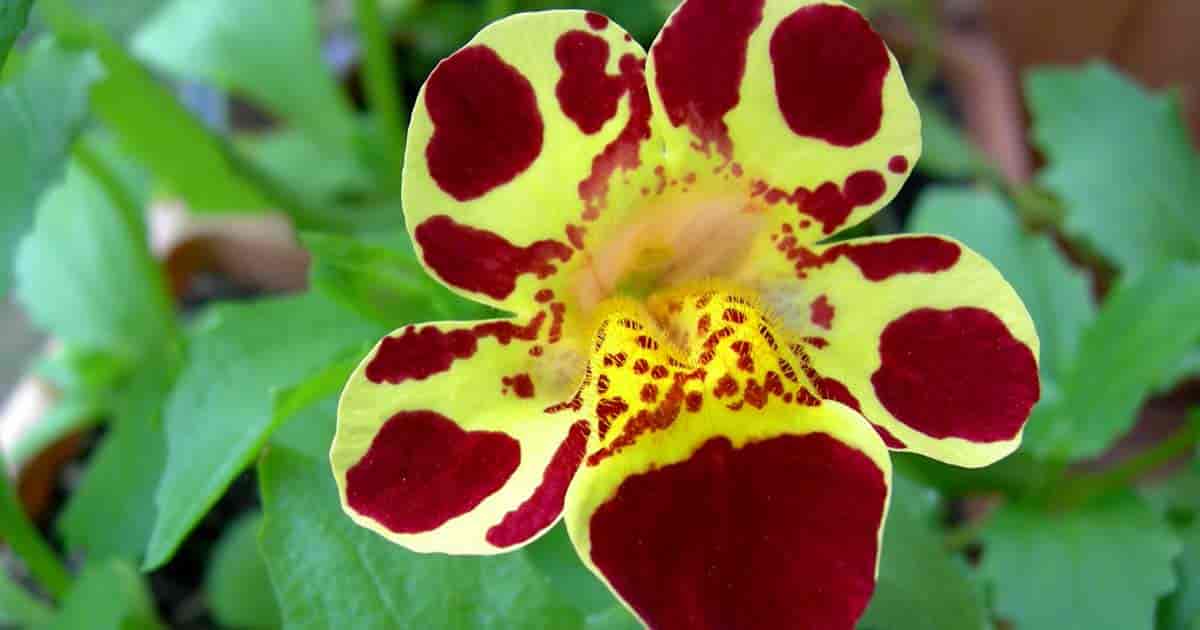Monkey flower, Mimulus (MIM-yoo-luss) is an herbaceous perennial wildflower.
The genus Mimulus was formerly part of the family Scrophulariaceae (Figwort family) before joining the family Phrymaceae (Lopseed family).

Some list the genus as Diplacus. Various species of the plant are native to many different parts of South and North America.
Mimulus grows naturally in a variety of settings.
For example, Mimulus ringens (RIN-jens) which is native to Missouri grows naturally in areas with plentiful, consistent water, such as:
- Low woods
- Swamps
- Wet meadows
- and along the sides of streams and ponds.
NOTE: Mimulus guttatus Yellow monkey flower is another species enjoying low lying wet areas.
Mimulus aurantiacus (aw-ran-ti-AYE-kus) is native to the West Coast from Oregon, California, and south to Mexico where it grows naturally in sandy, rocky soil on slopes, cliffs, and hillsides.
It pops up in areas where the soil has recently been disturbed.
You’ll find this California native growing naturally forests of pine, Redwood and mixed evergreens.
It also does well mixed in with coastal scrub, chaparral and in desert settings.
Common names for the various species include:
- Square Stemmed Monkey Flower
- Allegheny Monkey Flower
- Shrubby Monkey Flower
- Sticky Monkey Flower
- Bush Monkey Flower
- Monkey Flower
These plants are all referred to as monkey flowers because the blossoms are said to resemble a smiling monkey face.
The plant’s genus name, Mimulus, is derived from the Latin word, ‘mimus’, which means mimic.
This is a reference to the bloom’s resemblance to a monkey’s face.
Mimulus Care
Size & Growth
Mimulus typically grow to heights ranging from 1′ foot to 3′ feet with a spread of about 1′ foot.
In exceptionally ideal circumstances, the plant may grow to be 4′ feet high.
The 2″ to 4″ inch long sharp-toothed, lance-shaped leaves grow in opposing pairs along the stems.
Leaves are sticky on the top and somewhat furry.
Flowering & Fragrance
Yellow flowers are the most common but monkey flowers come in many colors depending upon the species and the part of the country where the plant grows.
Blooms range in color from:
- Red
- Lilac
- White
- Orange
- Deep Purple
Flowers display a larger swollen lower lip with 3 lobes and a smaller upper corolla lip with 2 lobes.
Bloom time typically runs from June through September.
The flowering stems grow vertically and the flowers are similar in appearance to snapdragons.
The opposite leaves grow in pairs along the leaf axils on slender pedicels one or two inches long.
Light & Temperature
These plants do well in partial shade to full sun settings depending upon the specific species grown.
As native plants, they do well at the temperature typical in spring and summer for the area where the species naturally occurs.
Watering & Feeding
As wildflowers, these plants typically do well with a watering regimen that mimics the natural rainfall or water availability of the local area.
Species which grow naturally in muddy settings must be kept consistently moist.
Those who thrive in open meadows or desert settings will do better with deep, occasional watering.
These native plants need no fertilizer as long as they are growing in good soil.
Soil & Transplanting
Ideal soil qualities vary from one species of Mimulus to another.
Those who thrive in dry or desert settings need well-draining, sandy, airy soil.
Those thriving in boggy settings need a moisture holding soil mixture.
One containing peat moss and/or organic compost is ideal.
Grooming & Maintenance
Mimulus require no special grooming!
How To Propagate Mimulus Flower
In ideal growing conditions, the plant will naturalize easily and spread through creeping rhizomes and self-seeding.
Mimulus Pest or Disease Problems
This native plant is fairly impervious to disease and insect problems. These plants are deer resistant.
Are MonkeyFlowers Considered Toxic or Poisonous?
There appears to be no listing for any species of Mimulus in the FDA Poisonous Plant List Database.
Is The Monkeyflower Plant Considered Invasive?
Because many species of Mimulus are native throughout Canada and the United States, the plant cannot be considered invasive.
Mimulus or Diplacus aurantiacus is an important host plant for the larvae of the Baltimore and common buckeye butterfly.
Suggested Mimulus Uses
To determine the best use of the Monkey Flower native to your area, you’ll need to familiarize yourself with the type of soil and setting found where it naturally grows.
Plants best suited to a boggy, swampland setting will be your best choice for low-lying areas or the margins of ponds and streams.
Those native to a dry, desert-like setting will be your best choice for naturalizing in open, airy meadows or for use in xeriscaping, in a rock garden, window boxes, baskets and garden borders.
Hummingbirds and bees find them attractive.